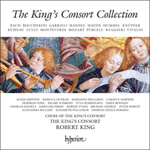
Welcome to Hyperion Records, a British classical label devoted to presenting high-quality recordings of music of all styles and from all periods from the twelfth century to the twenty-first.
Hyperion offers both CDs, and downloads in a number of formats. The site is also available in several languages.
Please use the dropdown buttons to set your preferred options, or use the checkbox to accept the defaults.

The influence of Pergolesi on Boccherini’s setting of the Stabat mater, the sequence for the Feast of Seven Dolours of the Blessed Virgin Mary, is abundantly clear. Like Pergolesi, Boccherini chooses the melancholy key of F minor and a bittersweet mood of tender supplication, juxtaposed with vocal writing that would more normally be associated with opera. The same sighing appoggiaturas and advanced harmony that made Pergolesi’s work so forward-looking for its time are still present: even the famous Pergolesi walking bass is heard at the opening of the final section.
Throughout Boccherini’s remarkable succession of solos, duets and trios there is a constant flow of invention. Here is writing of extraordinary individuality from a composer, nearing the end of his life, setting one of the most poignant of all sacred texts with an open Christian conviction that comes straight from the heart. The opening, large-scale movement mixes string writing of startling, anguished textures (also showing Boccherini’s fastidious eye for expressive detail) with ravishing vocal melancholy. The gentle ‘Cuius animam’, still gloriously bittersweet, is interrupted at its conclusion by the second soprano, setting up the melodic ‘Quae maerebat’. A winding violin melody introduces the accompagnato-like ‘Quis est homo’ and a tender ‘Pro peccatis suae gentis’, in which Jesus gives up his spirit with exquisite, gentle simplicity. The ‘Eia mater, fons amoris’ is particularly striking, the instrumental prelude coloured by Boccherini’s favoured cello playing in its rich treble tessitura, the sopranos eloquently and operatically duetting.
The busy vocal trio ‘Tui nati vulnerati’ is introduced by active string figurations, scales flying, with contrast supplied by a slow, veiled middle section. ‘Virgo virginum praeclara’ is another masterpiece: the instrumental texture of solo violin, accompanied by pizzicato cello, viola countermelody and the second violin’s gently rocking figurations, creates a rich cushion of sound for a ravishing soprano melody. The second soprano’s ‘Fac ut portem’ is lyrical in its gentle rocking 6/8 rhythm, followed by the total contrast of the aggressive, triumphant trio ‘Fac me plagis’. For ‘Quando corpus’ such operatic devices are forgotten: Pergolesi’s bass returns in a mood of total submission—all passion has been spent. The bells of paradise gently chime in the violins, and the work closes with Boccherini’s serene picture of the world to come. This extraordinary, neglected masterpiece is surely one of the most remarkable sacred compositions of the era.
from notes by Robert King © 1999
L’influence de Pergolèse sur le Stabat mater—la séquence pour la fête des Sept douleurs de la Vierge Marie—de Boccherini est des plus manifestes. Comme Pergolèse, Boccherini choisit la mélancolique tonalité de fa mineur et une atmosphère aigre-douce de tendre supplique, juxtaposée à une écriture vocale opératique. S’y retrouvent les mêmes appoggiatures soupirantes, la même harmonie évoluée qui valurent à l’œuvre de Pergolèse son caractère précurseur: même la fameuse «walking bass» de Pergolèse se fait entendre au début de la section finale.
La remarquable succession de solos, de duos et de trios est, chez Boccherini, traversée d’un constant flot inventif. Nous sommes en présence d’une écriture extraordinairement personnelle, œuvre d’un compositeur qui, approchant de sa fin, mit en musique l’un des textes sacrés les plus poignants, avec une conviction chrétienne évidente, tout droit jaillie du cœur. Le mouvement d’ouverture, à grande échelle, allie écriture pour cordes aux textures étincelantes et angoissées (reflets de l’œil méticuleux de Boccherini pour le détail expressif) et ravissante mélancolie vocale. Le paisible «Cuius animam», encore glorieusement aigre-doux, voit sa conclusion interrompue par le second soprano, entreprenant le mélodique «Quae maerebat». Une ondoyante mélodie violonistique introduit le «Quis est homo», de type accompagnato, puis un tendre «Pro peccatis suae gentis», où Jésus rend l’âme avec une simplicité exquise, douce. L’«Eia mater, fons amoris» est particulièrement saisissant: le prélude instrumental est coloré par le jeu violoncellistique favori de Boccherini, dans sa riche tessiture aiguë, cependant que les sopranos réalisent un éloquent et opératique duo.
L’animé trio vocal «Tui nati vulnerati» est introduit par d’actives figurations aux cordes, où les gammes s’envolent, en contraste avec une section médiane lente, voilée. «Virgo virginum praeclara» est un autre chef-d’œuvre: la texture instrumentale du violon solo, accompagné de pizzicati violoncellistiques, ainsi que du contre-thème (alto) et des figurations doucement cullando du second violon, crée un foisonnant coussin sonore où asseoir une mélodie de soprano. Le «Fac, ut portem» du second soprano, lyrique dans son paisible rythme cullando à 6/8, est suivi de l’agressif et triomphant trio «Fac me plagis», en total contraste. Pareils procédés opératiques sont oubliés pour «Quando corpus»: la basse de Pergolèse revient dans une atmosphère de complète soumission—toute passion a été épuisée. Les cloches du paradis carillonnent quiètement aux violons et l’œuvre s’achève sur le serein tableau boccherinien du monde à venir. Négligé, cet extraordinaire chef-d’œuvre est assurément l’une des plus remarquables compositions sacrées de l’époque.
extrait des notes rédigées par Robert King © 1999
Français: Hypérion
Der Einfluß Pergolesis auf Boccherinis Vertonung des Stabat mater, der Sequenz zum Fest der Sieben Schmerzen Mariens, ist klar erkennbar. Wie Pergolesi wählt Boccherini die melancholische Tonart f-Moll sowie eine bittersüße Stimmung zärtlichen Flehens und setzt dagegen einen Vokalsatz, wie man ihn eher mit der Opernbühne verbinden würde. Die seufzenden Vorschläge und anspruchsvollen Harmonien, die Pergolesis Werk zu seiner Zeit so vorausschauend wirken ließen, sind auch hier vorhanden; selbst Pergolesis berühmter Laufbaß ist in der Eröffnung des Finalabschnitts zu hören.
Boccherinis bemerkenswerte Abfolge aus Soli, Duetten und Trios besticht durch fortwährenden Ideenreichtum. Das Werk zeugt von der außerordentlichen Individualität eines Komponisten, der in seinen letzten Lebensjahren einen der ergreifendsten aller geistlichen Texte mit unverhohlener, direkt von Herzen kommender christlicher Überzeugung vertont hat. Der großangelegte erste Satz vereint eine von erstaunlichen, qualvollen Strukturen geprägte Streicherführung (die auch Boccherinis gutes Auge für expressive Details belegt) mit hinreißender Melancholie der Gesangsstimmen. Das sanfte, immer noch wunderbar bittersüße „Cuius animam“ wird gegen Ende vom zweiten Sopran unterbrochen, der das melodische „Quae maerebat“ vorbereitet. Eine gewundene Geigenmelodie führt das an ein Accompagnato gemahnende „Quis est homo“ und ein zärtliches „Pro peccatis suae gentis“ ein, in dem Jesus mit erlesener, sanfter Schlichtheit sein Leben aushaucht. Das „Eia mater, fons amoris“ ist besonders eindrucksvoll—die von Boccherini bevorzugte, üppig klingende hohe Tessitura des Cellos bestimmt das instrumentale Vorspiel, und die Soprane duettieren beredt und opernhaft.
Das lebhafte Gesangstrio „Tui nati vulnerati“ wird von geschäftigen Streicherfigurationen voll behender Läufe eingeleitet; für Kontrast sorgt ein langsamer, verschleierter Mittelabschnitt. „Virgo virginum praeclara“ ist ein weiteres Meisterstück: Die instrumentale Struktur, bestehend aus der Sologeige, die von pizzicato gespielten Celli begleitet wird, einer Gegenmelodie der Bratschen und sanft wiegenden Figuren der zweiten Geigen, bildet ein üppiges Klangpolster für eine hinreißende Sopranmelodie. Das „Fac ut portem“ des zweiten Soprans mit seinem behutsam wogenden 6/8-Rhythmus wirkt lyrisch, in völligem Gegensatz zum folgenden, von Aggression und Triumph gekennzeichneten „Fac, me plagis“. Bei „Quando corpus“ sind derartige opernhafte Kunstgriffe vergessen: Pergolesis Baß kehrt im Gemütszustand vollkommener Unterwerfung wieder—alle Leidenschaft hat sich erschöpft. Die Glocken des Paradieses klingen sanft in den Geigen an, und das Werk schließt mit Boccherinis heiter gelassener Vorstellung von der künftigen Welt. Dieses außerordentliche vernachlässigte Meisterwerk ist sicherlich eine der bemerkenswertesten geistlichen Kompositionen seiner Epoche.
aus dem Begleittext von Robert King © 1999
Deutsch: Anne Steeb/Bernd Müller
 Boccherini & Astorga: Stabat mater Boccherini & Astorga: Stabat materA recording of two extremely beautiful settings of the Stabat mater—the Astorga is better-known than the Boccherini, but if any recording proves that a piece should be neglected no longer, this must surely be it.» More |
 The King's Consort Collection The King's Consort Collection'An uplifting disc, and nicely presented—I can certainly recommend this as an example of both fine music and exquisite performances' (MusicWeb Interna ...» More |

